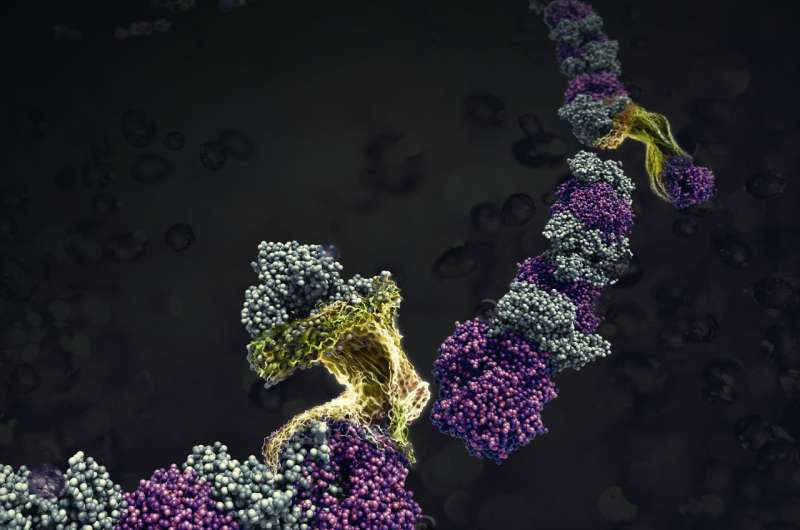When proteins shake hands

Protein fibres are found virtually everywhere in nature, including in spider silk, wood, the spaces between tissue cells, in tendons, or as a natural sealant for small wounds. These protein nanofibres have outstanding properties such as high stability, biodegradability, and antibacterial effects. Artificially creating these fibres is not easy, much less assigning them specific functions. These issues are discussed by materials scientists from Friedrich Schiller University Jena (Germany) in the latest issue of ACS Nano.
"Protein fibres consist of several natural protein macromolecules," explains Prof. Dr. Klaus D. Jandt from the Otto Schott Institute of Materials Research at Jena University. "Nature builds these nanomaterials by way of self-assembly processes." It is quite difficult to replicate natural fibres under laboratory conditions. Prof. Jandt and his team have, in recent years, created protein nanofibres from the natural proteins fibrinogen and fibronectin and controlled their size and linear or branched structure.
The researchers of Prof. Jandt's group next aimed to predefine specific properties of the protein nanofibres for later use as components in biosensors, drug delivery particles, optical probes or bone cements. To do this, they sought to combine two proteins in a self-assembling protein nanofibre in order to create new properties. They successfully used the protein albumin, which is responsible for the osmotic pressure in blood, and haemoglobin, the protein of the red blood pigment facilitating oxygen transport in the blood. The scientists dissolved both these proteins in ethanol and then heated them to 65 °C. Over several interim stages, this resulted in the apparently autonomous formation of new hybrid protein nanofibres containing both proteins for the very first time. This involves a so-called "handshake" between the two proteins, meaning that similar sections of both combine to form a fibre.
"Proving that these new hybrid protein nanofibres contain both proteins was not easy, as the new fibres are so tiny that there are hardly any microscopy methods able to see details in them," says Klaus Jandt.
Prof. Dr. Volker Deckert and his team found optical signals in the new hybrid nanofibres that are typical for albumin and haemoglobin using tip-enhanced Raman spectroscopy (TERS). "The method's extreme sensitivity allowed us to identify the different proteins even without special markers, and also permitted their unambiguous classification in close cooperation with Prof. Jandt's colleagues," says Prof. Deckert from the Leibniz-IPHT in Jena.
The innovative fibres can be used for the targeted construction of new, larger structures with desired properties that were previously unobtainable. Networks of the new nanofibres could be used as a new material for regenerating bone and cartilage in the future, for example. Prof. Jandt says, "This has opened the door for a completely new generation of functional materials for medical engineering, nanoelectronics, sensorics, or optics, all based on natural substances and construction principles. These biomimetic principles will have a decisive effect on the materials of the future." The scientists from Jena are confident that this new self-organization approach can also be successfully transferred to other proteins as long as they feature identical amino acid sequences in parts.
More information: Christian Helbing et al, Protein Handshake on the Nanoscale: How Albumin and Hemoglobin Self-Assemble into Nanohybrid Fibers, ACS Nano (2018). DOI: 10.1021/acsnano.7b07196
Journal information: ACS Nano
Provided by Friedrich Schiller University of Jena



















